A couple of weeks ago I took an audio walking tour of Beacon Hill. This historic neighborhood has been home to both politicians and poets as well as some of the most beautiful streets in the city of Boston.

One distinct feature of the streets of Beacon Hill are the lamp posts. To this day, these lamp posts continue to be lit by gas as they have always been. It definitely adds to the historic charm of the neighborhood.
Walking up the hill, the first stops on the tour are on the beautiful Mt. Vernon Street. This street is home to many historic homes.
A fall day adds to the beauty of this street.

The first stop on the street is the Nichols House Museum located at 55 Mt. Vernon Street. This home was built in 1804 by architect Charles Bulfinch. Since 1961, this house has served as a museum which gives you a look at the life of Beacon Hill over the 19th and 20th centuries. Landscape architect, peace activist and suffragist Rose Standish Nichols live here her whole life and her family’s original art and furnishings are on display in the museum.
Next door is 57 Mt. Vernon Street, which was home to two different politicians. Daniel Webster who served as both US Senator and Secretary of State lived at this address. You may know him as a character in Mark Twain’s “The Devil and Daniel Webster”. Charles Francis Adams, Sr. also resided in this house. He was grandson of the 2nd US President John Adams and son of the 6th US President John Quincy Adams. He was also in politics himself, serving as a state senator and an ambassador to the United Kingdom during the Civil War.
Next up is 65 Mt. Vernon Street where yet another politician lived. Senator and first unofficial Senate Majority Leader, Henry Cabot Lodge lived in this house. He is best known for his disagreement with President Woodrow Wilson over the Treaty of Versailles. While President Wilson wanted to join the League of Nations without any reservations, which could force the United States into war without the approval of Congress, Lodge was in favor of reservations. These reservations were incorporated into the League of Nations’ successor the United Nations and hence gave the US veto power.
The Harrison Gray Otis House at 85 Mt. Vernon Street is the last remaining freestanding house in Beacon Hill. It was home to Harrison Gray Otis who was the third mayor of Boston as well as a US Congressman and US Senator.
At 88 Mt. Vernon Street, we come to a house, not known for a politician but instead for a famous poet. From 1938 – 1941, Pulitzer Prize winning poet Robert Frost lived at this home. Across from this home is one of the most expensive streets to live in the United States, Louisburg Square. Louisa May-Alcott, best known for her novel Little Women, once lived on this street.
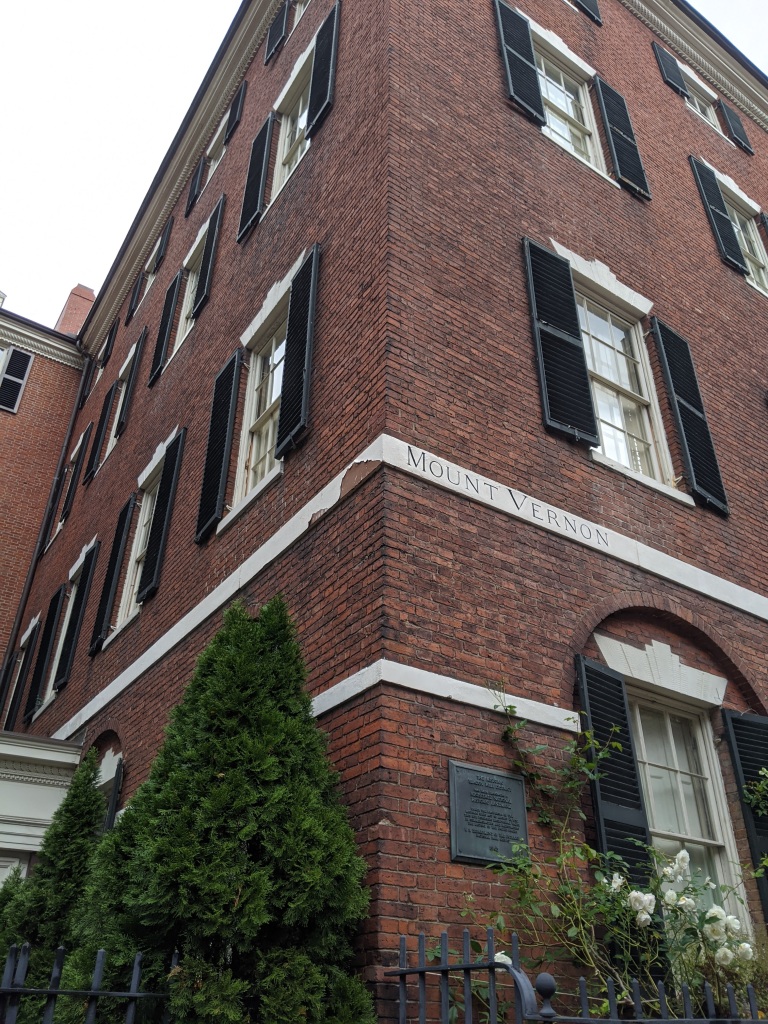
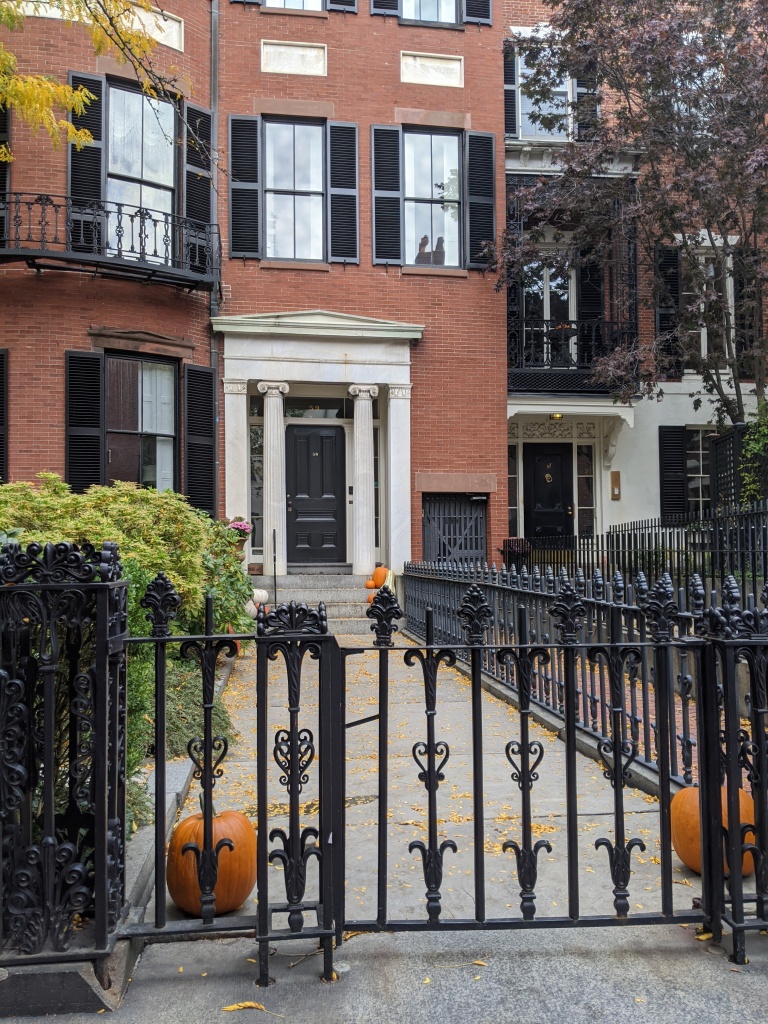
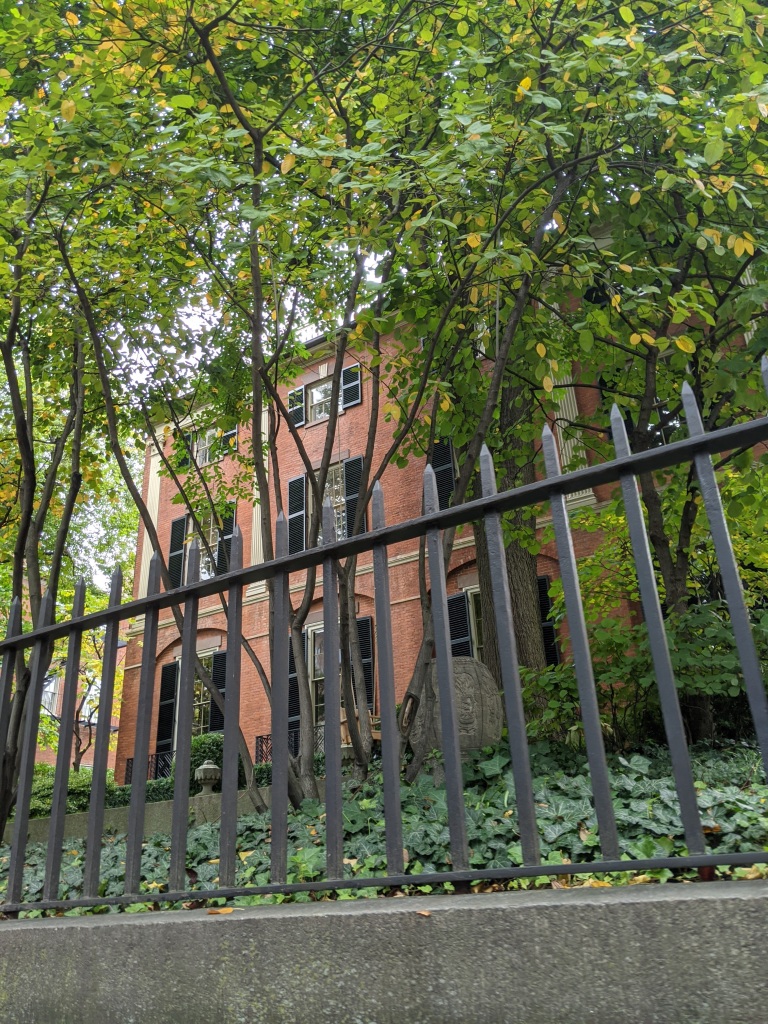
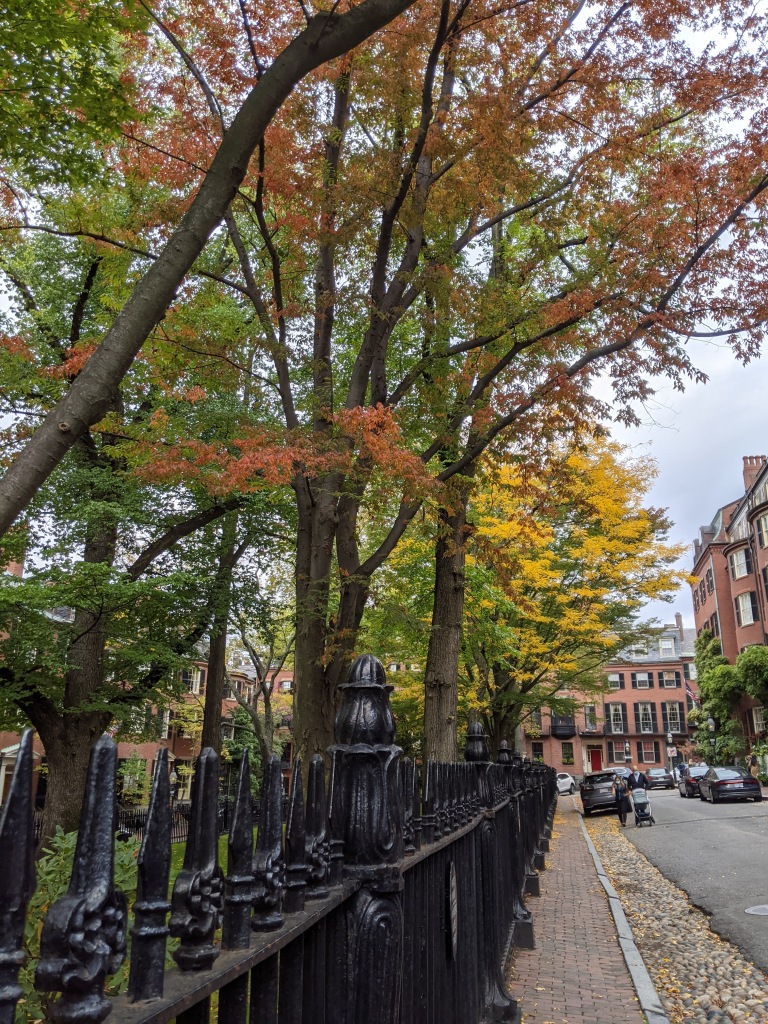
From Mt. Vernon Street, it’s off to the most photographed street in Boston, Acorn Street. The view from the bottom of the street looking up is the best. Being that it’s the most photographed street and with everyone being a photographer nowadays with their smartphone, it’s difficult to get a photo without a lot of other people around. You will definitely see plenty of people there trying to get that instagram worthy shot or the perfect selfie.

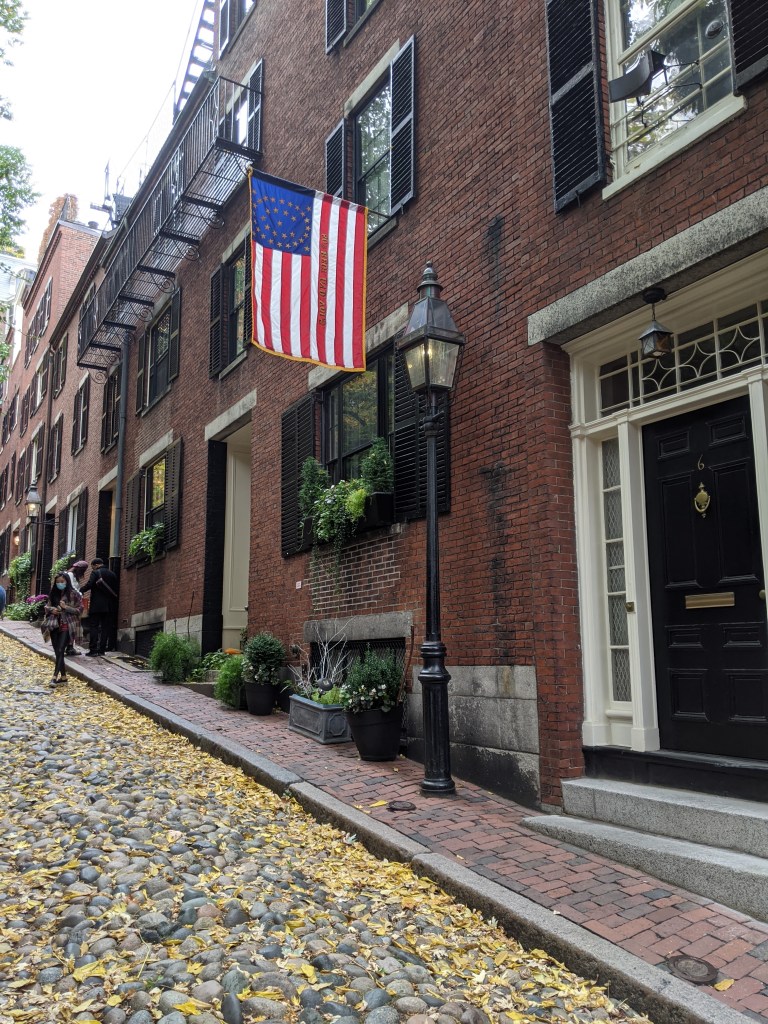

What makes this the most photographed street, you may ask? Well, it’s one of the few streets in the city that has the original cobblestones. These cobblestones and the brick buildings definitely make for a beautiful street, throw in a US flag and some seasonal decorations and it definitely makes for a great photo!

Located at 84 Beacon Street is that place where “Everybody knows your name”, the Bull & Finch Pub, otherwise known as Cheers.
This is a great place to grab a drink and some food. But don’t be shocked when you walk inside, it’s ALOT smaller than the bar in the tv show!

Another great place to stop for a bite to eat is at the Paramount at 44 Charles Street. Although this is an absolute great restaurant, it’s not the restaurant that makes this building famous, it’s the second floor apartment.
This apartment was home to Mary Sullivan. At 19 years old she was the last and youngest victim of Albert DeSalvo, otherwise known as the “Boston Strangler”. On January 4, 1964, just three days after she moved in, Mary’s body was found in the apartment.
Although the scene of this murder was similar to the other victim’s scenes, there was a striking difference. Next to Mary’s foot was a note addressed to the Boston Police that said Happy New Year. There were not notes left at any of the other crime scenes. Her family argued that she was killed not by the “Boston Strangler” but by an ex boyfriend.
In 2013, they compared DNA from the crime scene with a living relative of DeSalvo’s and it produced a match so they exhumed DeSalvo’s body and ran a DNA test, results of which stated that the odds of the DNA belonging to someone other than DeSalvo were 1 in 220 billion. I guess it’s safe to say Mary Sullivan was in fact his final victim.

The Charles Street Meeting House at 70 Charles Street was a major part of Boston’s Abolitionist movement. People such as William Lloyd Garrison, Frederick Douglass, Sojourner Truth and Charles Sumner all spoke here.
It became the Charleston Street African Methodist Church, which was one of the largest of the black churches in Boston after the Civil War.

The Sunflower House is located at 130 Mt. Vernon Street near Charles Street.
In 1904, watercolor artist Gertrude Beals moved into this house. Her studio was located on the third floor of the home. On the outside of the house on the third floor is a sunflower. This sunflower is what gave the home it’s name.
One of Gertrude’s paintings was of her in the third floor studio and it was titled “The Artist’s Studio-Sunflower Castle”.

The final stop on the tour was the Liberty Hotel. The hotel is the former site of the Charles Street jail. It was a jail from 1851-1990 and housed inmates such as Malcolm X and Boston Mayor James Michael Curly.
Forced to close in 1973 due to overcrowding violating prisoner rights, it finally shut down in 1990.
It then became the luxury hotel, The Liberty Hotel. It’s a beautiful hotel with a jail theme. The two lounges in the hotel are called The Clink and Alibi’s. At Alibi’s, which is located where the former drunk tank of the jail was, you can enjoy a drink behind steel bars with mug shots of popular celebrities such as Frank Sinatra, Mickey Rourke and Lindsay Lohan.
If you’re looking for a place to stay in Boston, definitely check out the Liberty Hotel.


Beacon Hill isn’t normally top of people’s list when visiting Boston, but it is definitely worth a visit. I’ve been to the Liberty Hotel and checked out the restaurants and shops on Charles Street many times, but I never knew much of the history of the Beacon Hill neighborhood. If you are looking for a great audio tour, check out the Atlantis Audio Tours app and let it lead your thru this beautiful Boston neighborhood full of history!
Pin for later:


Beautiful pictures and it looks like a wonderful place to visit in Boston!
LikeLiked by 1 person
What beautiful photos! And thank you for sharing some of the history!
http://Www.sophiapatel.co.uk
LikeLiked by 1 person
We’ve walked these streets before but oblivious to who has lived there and what its history was. This fills in a heap of gaps.
LikeLiked by 1 person
I grew up in Boston and I didn’t know all this history either. These audio tours really are a great way to learn more about an area on your own time schedule.
LikeLike
So much great history here!
LikeLiked by 1 person
I love Beacon Hill! I’ve been to Boston countless times and yet I learned so many fascinating bits of history reading this. Very interesting how they confirmed the Boston Strangler’s last victim was Mary. Love that sunflower house too!
LikeLiked by 1 person
Lovely photos! What a wonderful time to photograph those historic buildings and streets with the changing leaves on the trees. Thanks for sharing!
LikeLiked by 1 person
Incredible! I learned so much from this post. I love that there are still gaslit lamps and original cobblestones. Besides the strangler, beacon hill has so much history and beauty. Thanks for sharing!
LikeLiked by 1 person
Glad you enjoyed it!
LikeLike
A beautiful place for a walk 😊
LikeLiked by 1 person
A jail turned hotel? Sign me up!
LikeLiked by 1 person
It’s really beautiful too! I need to go take some pictures inside some day and update this post
LikeLike
I’ve only visited Boston once for a work conference. I plan to revisit one day and will def. visit Beacon Hill. Thanks for this!
LikeLiked by 1 person
Excellent photos and great guide!
LikeLiked by 1 person
What a beautiful area for a autumn walk. Boston’s Beacon Hill looks gorgeous and I love all those historical buildings.
LikeLiked by 1 person
These are my favorite activities when traveling – seeing all the history of a place. What a beautiful neighborhood!
LikeLiked by 1 person
The Bull & Finch Pub looks like a nice cozy place I would like to visit. Not sure about the Paramount at 44 Charles Street though.. What a story!
LikeLiked by 1 person
Robert Frost and Louisa May Alcott—quite the literary powerhouse in one small part of the city. Would love to check out this historic and literary part of Boston.
LikeLiked by 1 person
COVID permitting I am hopefully going to be in Boston in a couple of weeks’ time so this guide is super useful! I have saved it so I can refer back to it when I’m there. Thank you!
LikeLiked by 1 person
I hope you are able to go to Boston. Covid certainly is making it difficult to plan things now
LikeLike